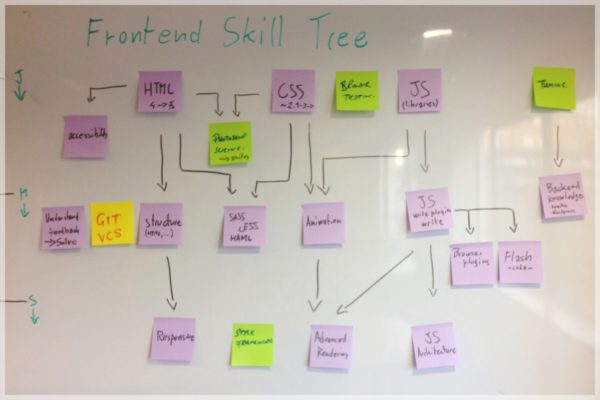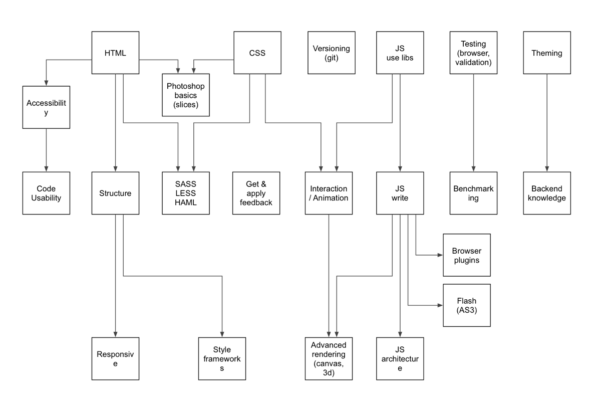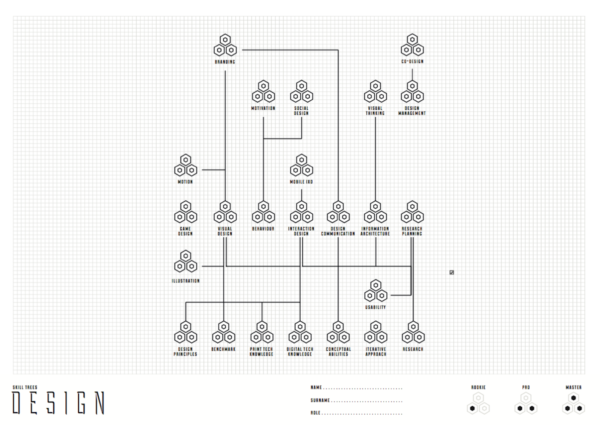One of the key elements of skill trees is that they are at the crossroad between professional skills and business needs. This means that each company has to craft their own. Ideally this is a collaborative process, and it takes actually less than one might think.
The process to create the skill trees can be summarized as follow:
- Identify — define the internal professions for which each tree should be built.
- Workshop — pool together people from each group and create a first draft collaboratively.
- Draft — review and standardize terminology to create a first draft.
- First run — start using them for self-assessment and create support tools to learn each skill.
- Launch — drafts polished, now the model can be shared with the company as a whole.
- Reassess — review periodically their completeness.
1. Identify
It’s important to start with an understanding of the business needs and how to group people in the company in a way that’s effective, with a balance between too much granularity and too little detail.
There might be a variety of roles in a company, and a lot of different business units, especially if the company is very large. If a company has both product design and research as separate business units, it might still make sense to have a single themed tree that grouped both interests. To be effective, it’s important to consider the tool of skill trees as something that can be compiled in a short time, say 10-20 minutes. Each person shouldn’t have more than 3-4 of them to assess. This is a rule of thumb that can help them being effective: if it feels too much like bureucracy it’s likely they are too complicated.
You can also do some preeliminary interviews at this stage, as some skill set might be useful across different groups. For example in one of my previous experiences we identified early “consulting” as a transversal skill tree that contained client facing abilities, and that tree was available to anyone, regardless of which role, that was client facing.
The outcome of this step can be as simple as a list of themes like this:
- Design
- Development
- Customer Care
- Marketing
- Soft skills
Or this:
- Sales
- Marketing
- Engineering
- Mentoring
2. Workshop
This is the most important part: once the general themes for the skill trees are identified, a group of people from relevant parts of the company are invited to a workshop where the first draft of the skill trees will be outlined.
There should be a workshop for each theme, and I would suggest to not have more than 20 participants in each.

The workshop is run following these steps:
- Explain what skill trees are, and if possible show an entirely unrelated example of one from a company and a skillset that is not relevant. You can make up one yourself in advance.
- Ask everyone in the room to write down the skills they either have or would like to have, one on each post-it
- In turn, everyone goes to put up the post-its on the wall, explaining what that skill is, and why it’s relevant to them and to the business. If there are already similar post-its on the wall, group them together.
- Transform each group to a single post-it with an agreed name, maybe keeping note of how many post-its there were in that group.
- Organize the post-its in trees, connecting the skills that are pre-requisite of others together. This doesn’t have to be strict: it’s very likely there’s a lot of overlap, it has to be just an indicative idea. Imagine it more in terms “if I wanted to do a class about this topic, I’d talk about these in a sequence”.
- The skill tree draft for that specific theme is now complete, you can review and discuss before wrapping up.
Ideally each tree shouldn’t be too crowded imagine each tree to be between 8 and 20 skills It should have a part that is aspirational: skills that are not very present as a business, or are useful but are under-developed, but that are relevant.
If there are trees that are transversal (i.e. soft skills, mentoring, etc) it’s possible that each workshop will build two trees: the one related directly to their work, and the transversal one.
3. Draft
Once all the workshops are done there’s a draft skill tree for each theme. Visualize them in some way that is clear and shareable, aligned with the needs of the company. You might prepare them to be printed, to be just seen on screen, or even a small application. Any combination is possible as long as it’s easily shared.
At this stage if there are transversal trees, they are merged together from the various workshop to come up with a single draft version.

Each skill in the trees should have some form of ranking. Various version can exist, here are two ideas:
- From zero to three in incremental levels of proficiency. Don’t be too granular because this isn’t meant to be a precise score, but a way to grow. Zero means no knowledge, full score means I already know everything and I just need updates when there are news.
- In terms of interest: no interest nor knowledge, basic knowledge, advanced knowledge and mentoring capability. This can be useful to highlight people that can later be able to pair up with others to create teaching connections.
4. First run
With the drafts at hand, it’s ideal to do a first run with a small group of people: either a single team, a sample of people across the company or anything else.
It’s also important to go back to the managers of each division to share the result of the work done if they weren’t already involved in the workshops directly. This will make sure that criticism and feedback is incorporated early, and that they are contributing to the work as well.
The first run can be done as a small version of whichever process you plan to have with the skill trees once rolled out to the entire company, for example:
- Ask the people to self-assess themselves. This helps not just to understand how they see themselves (and uncover potential impostor syndrome) but also because at this early stage will show if the skill labels and descriptions are clear enough.
- Do 1:1 chats with every person to discuss their assessment, and identify which skills they want to improve and learn.
- Try to define a growth plan along these lines, and a date for a review (in a quarter, half a year, a year time).
5. Launch
With the information from the first run:
- You can refine and polish the skill trees.
- You know how culturally compatible this approach is, and if it’s the case to reassess or push forward.
- You have already achieved sharing of knowledge across teams and people, and a reflection on where the business stands in terms of their talents.

If it was successful, then the skill trees can now be extended to the company as a whole, making sure there’s capability to follow up on the 1:1 chats and growth plans.
6. Future Review
Since these skill trees aren’t universal but go hand in hand with the business goals, it’s important to review them periodically to add, modify or remove skills. The ideal time is around 2 years, or matching any other internal busines rhythm that might be already in place.
If there’s a larger transformation (i.e. a shift from an engineering driven to a design driven company) it’s important to redo the entire process from scratch, but also to do it with external people as talent as the company doesn’t have yet the kind of people that are able to create the needed skill trees.
This whole process might seem a lot but is actually very quick. A small company can do it even in a single day, but even a larger one is mostly the time to organize the workshops and allow the people to be present, more than actual full time investment.
Let me know how it goes if you give it a try.
Further readings
- Customer Support Skills Tree by Andrea Badgley — showing an excellent hands-on example on how her team created a skill tree for customer support.